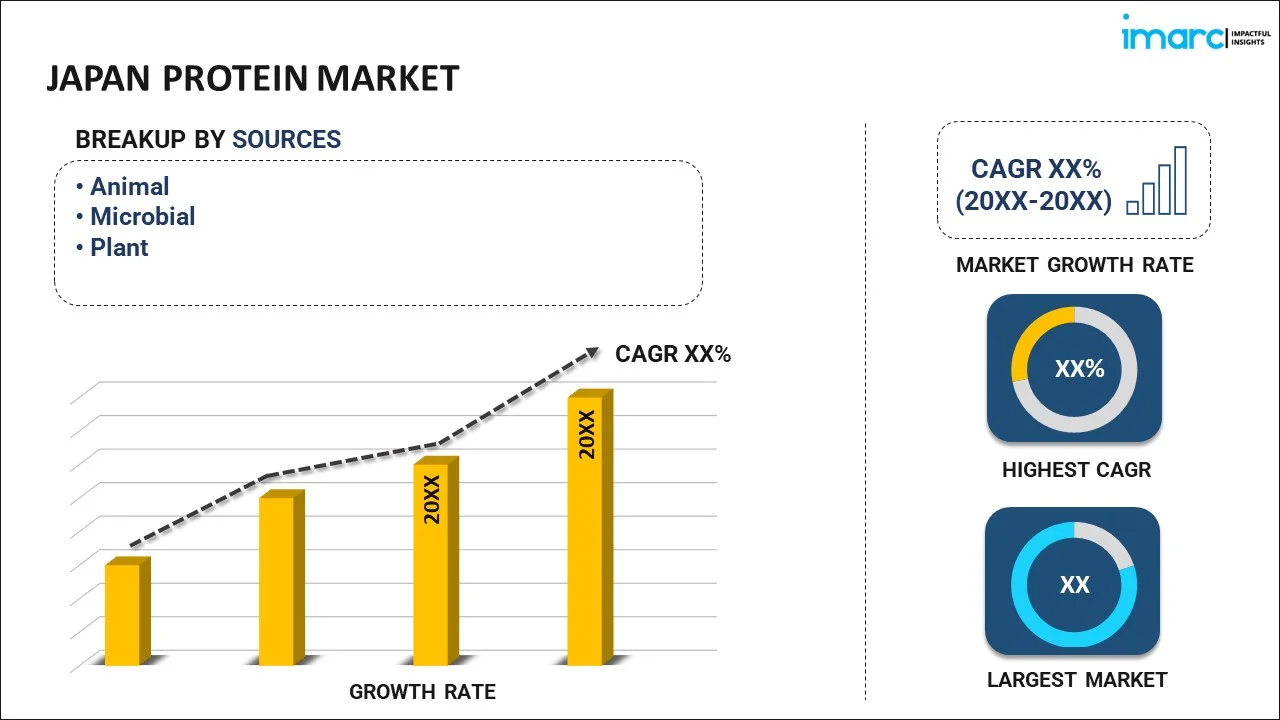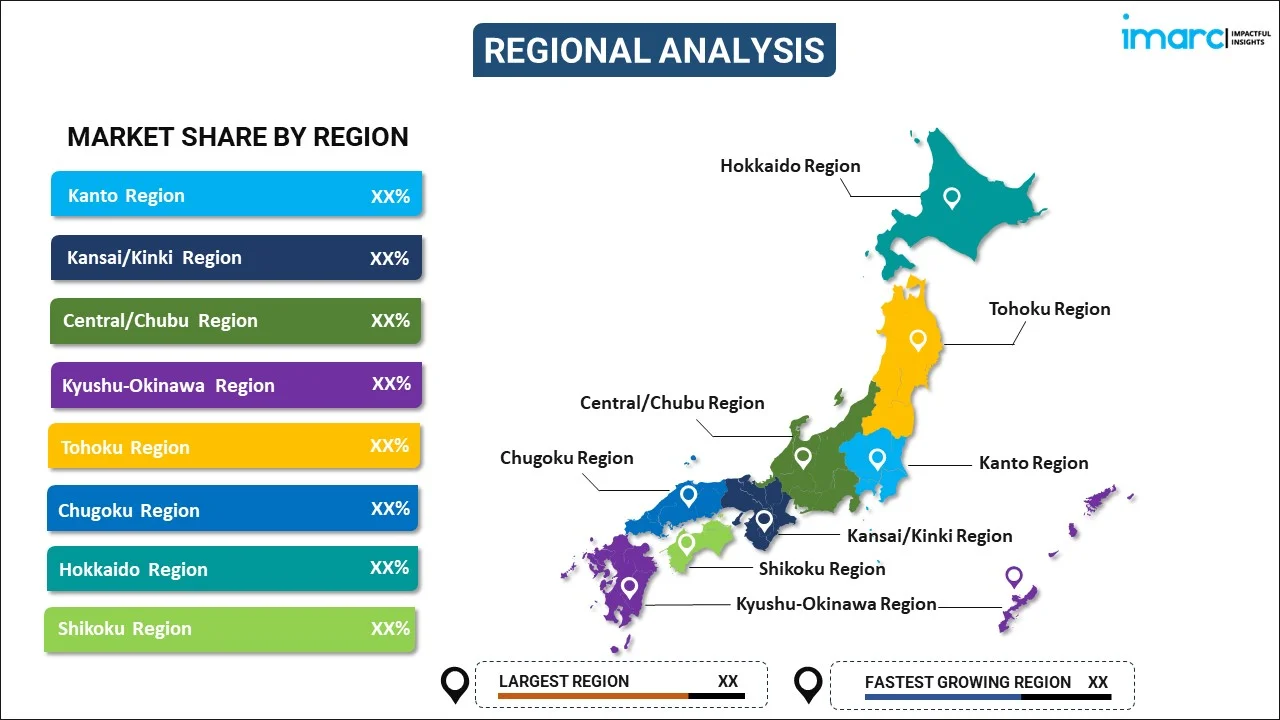
Japan Protein Market Report by Source (Animal, Microbial, Plant), End User (Animal Feed, Personal Care and Cosmetics, Food and Beverages, Supplements), and Region 2025-2033
Market Overview:
Japan protein market size reached USD 1.7 Billion in 2024. Looking forward, IMARC Group expects the market to reach USD 2.9 Billion by 2033, exhibiting a growth rate (CAGR) of 5.61% during 2025-2033. The increasing advances in food technology and biotechnology that have enabled the development of novel protein sources, such as plant-based meat substitutes, cultured meat, and insect-based product are driving the market.
|
Report Attribute
|
Key Statistics
|
|---|---|
|
Base Year
|
2024 |
|
Forecast Years
|
2025-2033
|
|
Historical Years
|
2019-2024
|
| Market Size in 2024 | USD 1.7 Billion |
| Market Forecast in 2033 | USD 2.9 Billion |
| Market Growth Rate (2025-2033) | 5.61% |
Protein is an essential macromolecule found in every living organism, serving a multitude of critical functions. Composed of amino acids linked together in specific sequences, proteins are responsible for various biological processes. Structural proteins, such as collagen and actin, provide stability and support to cells and tissues. Enzymes are proteins that catalyze biochemical reactions, facilitating metabolic processes like digestion and energy production. Antibodies, another type of protein, play a crucial role in the immune system by localizing and neutralizing pathogens. Hormones like insulin regulate bodily functions, while transport proteins carry molecules like oxygen in the blood or nutrients across cell membranes. Proteins are also involved in cell signaling, cell adhesion, and muscle contraction. The unique three-dimensional structure of proteins determines their function. Denaturation, caused by factors like heat or pH changes, can disrupt this structure, rendering the protein non-functional. In summary, proteins are fundamental biomolecules with diverse roles, including structural support, enzymatic activity, immune defense, and cellular communication, making them vital for life.
Japan Protein Market Trends:
Protein market drivers are influenced by a multitude of factors, and these interconnected elements shape the industry's growth trajectory. Firstly, the ever-expanding regional population acts as a foundational driver, increasing demand for protein-rich foods. Moreover, shifting dietary preferences, marked by a growing focus on health and wellness, propel the protein market forward. Consequently, consumers in Japan are seeking out alternative protein sources, including plant-based options, which is fostering innovation and competition. Additionally, the rise of fitness and sports culture has led to a surge in demand for protein supplements and functional foods, further amplifying market momentum. Apart from this, numerous technological advancements in food processing and biotechnology, which enhance the efficiency of protein production while reducing environmental impacts, are also augmenting the market growth. Furthermore, the emerging health-conscious trend, combined with a rising awareness about the importance of a well-rounded diet to boost immunity, is expected to drive the protein market in Japan.
Japan Protein Market Segmentation:
IMARC Group provides an analysis of the key trends in each segment of the market, along with forecasts at the country level for 2025-2033. Our report has categorized the market based on source and end user.
Source Insights:

- Animal
- Casein and Caseinates
- Collagen
- Egg Protein
- Gelatin
- Insect Protein
- Milk Protein
- Whey Protein
- Others
- Microbial
- Algae Protein
- Mycoprotein
- Plant
- Hemp Protein
- Pea Protein
- Potato Protein
- Rice Protein
- Soy Protein
- Wheat Protein
- Others
The report has provided a detailed breakup and analysis of the market based on the source. This includes animal (casein and caseinates, collagen, egg protein, gelatin, insect protein, milk protein, whey protein, and others), microbial (algae protein and mycoprotein), and plant (hemp protein, pea protein, potato protein, rice protein, soy protein, wheat protein, and others).
End User Insights:
- Animal Feed
- Personal Care and Cosmetics
- Food and Beverages
- Bakery
- Beverages
- Breakfast Cereals
- Condiments/Sauces
- Confectionery
- Dairy and Dairy Alternative Products
- Meat/Poultry/Seafood and Meat Alternative Products
- RTE/RTC Food Products
- Snacks
- Supplements
- Baby Food and Infant Formula
- Elderly Nutrition and Medical Nutrition
- Sport/Performance Nutrition
A detailed breakup and analysis of the market based on the end user have also been provided in the report. This includes animal feed, personal care and cosmetics, food and beverages (bakery, beverages, breakfast cereals, condiments/sauces, confectionery, dairy and dairy alternative products, meat/poultry/seafood and meat alternative products, RTE/RTC food products, and snacks), and supplements (baby food and infant formula, elderly nutrition and medical nutrition, and sport/performance nutrition).
Regional Insights:

- Kanto Region
- Kansai/Kinki Region
- Central/ Chubu Region
- Kyushu-Okinawa Region
- Tohoku Region
- Chugoku Region
- Hokkaido Region
- Shikoku Region
The report has also provided a comprehensive analysis of all the major regional markets, which include Kanto Region, Kansai/Kinki Region, Central/ Chubu Region, Kyushu-Okinawa Region, Tohoku Region, Chugoku Region, Hokkaido Region, and Shikoku Region.
Competitive Landscape:
The market research report has also provided a comprehensive analysis of the competitive landscape in the market. Competitive analysis such as market structure, key player positioning, top winning strategies, competitive dashboard, and company evaluation quadrant has been covered in the report. Also, detailed profiles of all major companies have been provided.
Japan Protein Market Report Coverage:
| Report Features | Details |
|---|---|
| Base Year of the Analysis | 2024 |
| Historical Period | 2019-2024 |
| Forecast Period | 2025-2033 |
| Units | Billion USD |
| Scope of the Report | Exploration of Historical Trends and Market Outlook, Industry Catalysts and Challenges, Segment-Wise Historical and Future Market Assessment:
|
| Sources Covered |
|
| End Users Covered |
|
| Regions Covered | Kanto Region, Kansai/Kinki Region, Central/ Chubu Region, Kyushu-Okinawa Region, Tohoku Region, Chugoku Region, Hokkaido Region, Shikoku Region |
| Customization Scope | 10% Free Customization |
| Post-Sale Analyst Support | 10-12 Weeks |
| Delivery Format | PDF and Excel through Email (We can also provide the editable version of the report in PPT/Word format on special request) |
Key Questions Answered in This Report:
- How has the Japan protein market performed so far and how will it perform in the coming years?
- What has been the impact of COVID-19 on the Japan protein market?
- What is the breakup of the Japan protein market on the basis of source?
- What is the breakup of the Japan protein market on the basis of end user?
- What are the various stages in the value chain of the Japan protein market?
- What are the key driving factors and challenges in the Japan protein?
- What is the structure of the Japan protein market and who are the key players?
- What is the degree of competition in the Japan protein market?
Key Benefits for Stakeholders:
- IMARC’s industry report offers a comprehensive quantitative analysis of various market segments, historical and current market trends, market forecasts, and dynamics of the Japan protein market from 2019-2033.
- The research report provides the latest information on the market drivers, challenges, and opportunities in the Japan protein market.
- Porter's five forces analysis assist stakeholders in assessing the impact of new entrants, competitive rivalry, supplier power, buyer power, and the threat of substitution. It helps stakeholders to analyze the level of competition within the Japan protein industry and its attractiveness.
- Competitive landscape allows stakeholders to understand their competitive environment and provides an insight into the current positions of key players in the market.
Need more help?
- Speak to our experienced analysts for insights on the current market scenarios.
- Include additional segments and countries to customize the report as per your requirement.
- Gain an unparalleled competitive advantage in your domain by understanding how to utilize the report and positively impacting your operations and revenue.
- For further assistance, please connect with our analysts.
 Inquire Before Buying
Inquire Before Buying
 Speak to an Analyst
Speak to an Analyst
 Request Brochure
Request Brochure
 Request Customization
Request Customization




.webp)




.webp)












